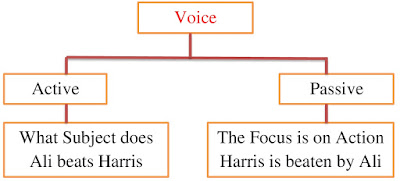Lesson of Assertive Sentence Voice Change Subject English Grade 9th

Lesson of Assertive Sentence Voice Change Subject English Grade 9 th Students` Learning Outcomes Information for Teachers Passive form: be (is, am, are, was, were, being, been) + Past Participle Read these sentences: S omeone has broken this chair. (Active) This chair has been broken. (Passive) People always admire this picture. (Active) This picture is always admired. (Passive) Note: in sentences 2 and 4 by someone and by the people are dropped. No agents are required in these sentences. This is the modern trends in assertive sentences. Sometimes a verb in the active voice takes two objects a direct one (thing) and an indirect one (person). Either of them may be used as the subject in the passive voice, as; Harris gave me a pen. (Active) I was given a pen by Harris. (Passive) Mr. Kamal teaches us English. (Active) We are taught English by Mr Kamal or English is taught to us by Mr Kamal. Prepositions must not be left out with verbs requiring them, as; We must lo

